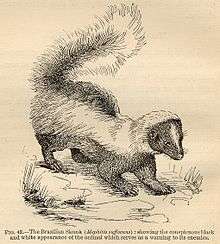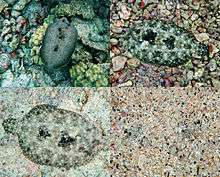Edward Bagnall Poulton
| Sir Edward Bagnall Poulton | |
|---|---|
|
Sir Edward Bagnall Poulton Photograph by James Lafayette | |
| Born | 27 January 1856 |
| Died | 20 November 1943 (aged 87) |
| Nationality | English |
| Fields | Evolutionary biology |
| Institutions | University of Oxford |
| Alma mater | Jesus College, Oxford |
| Known for | Aposematism, frequency-dependent selection, camouflage |
| Influences | Charles Darwin, August Weismann, Alfred Russel Wallace |
| Notable awards |
Linnean Medal (1922) Hope Professor of Zoology |
Sir Edward Bagnall Poulton, FRS[1] (27 January 1856 – 20 November 1943) was a British evolutionary biologist who was a lifelong advocate of natural selection through a period in which many scientists such as Reginald Punnett doubted its importance. He invented the term sympatric for evolution of species in the same place, and in his book The Colours of Animals (1890) was the first to recognize frequency-dependent selection.
Poulton is also remembered for his pioneering work on animal coloration. He is credited with inventing the term aposematism for warning coloration, as well as for his experiments on 'protective coloration' (camouflage).
Poulton became Hope Professor of Zoology at the University of Oxford in 1893.[2]
Life
Between 1873 and 1876, Poulton studied at Jesus College, Oxford under George Rolleston and the anti-Darwinian entomologist John Obadiah Westwood, graduating with a first-class degree in natural science.[3] He maintained an unbroken connection with the college for seventy years as scholar, lecturer and Fellow (appointed to a fellowship in 1898) until his death. He was known as a generous benefactor to the college, providing silver for the high table and redecorating the Old Bursary amongst other donations.[4]
Family
Poulton lived with his family at 56 Banbury Road in North Oxford, a large Victorian Gothic house designed by John Gibbs and built in 1866.[5] He married Emily Palmer, daughter of George Palmer, M.P. for Reading and head of Huntley and Palmer's biscuit company and they had five children. Three of them were dead by 1919. Their eldest son Dr. Edward Palmer Poulton of Guy's Hospital died in 1939, meaning that Sir Edward was outlived only by his daughter Margaret Lucy (1887-1965), wife of Dr Maxwell Garnett. Poulton's son, Ronald Poulton-Palmer played international rugby for England and was killed in May 1915 World War I. His first daughter Hilda married Dr Ernest Ainsley-Walker and died in 1917. His youngest daughter, Janet Palmer, married Charles Symonds in 1915 and died in 1919.[6]
Career

Poulton was throughout his career a Darwinist, believing in natural selection as the primary force in evolution. He not only admired Charles Darwin, but also defended the father of neo-Darwinism, August Weismann. Poulton was one of the group of biologists who first translated Weismann's work into English, and he defended Weismann's idea of the continuity of the germ-plasm. In the course of these translations, he noted that recent researches had reduced or perhaps entirely removed the role of acquired characters (Lamarckism, Neo-Lamarckism) in species formation.
His 1890 book, The Colours of Animals, introduced the concepts of frequency-dependent selection and aposematic coloration, as well as supporting Darwin's then unpopular theories of natural selection and sexual selection.[7]
In his 1896 work on Darwin,[8] Poulton described the Origin of Species as "incomparably the greatest work" the biological sciences had seen. Critics of natural selection, Poulton contended, had not taken the time to understand it. This is an evaluation which is much more widely held today than it was then. The contemporary ignorance of the mechanism of inheritance stood in the way of a full understanding of the mechanism of evolution.
In 1897 Poulton canvassed members during meetings of the Entomological Society of London. He discovered that many doubted a selectionist origin for mimicry. Of those he asked, only three fully supported Batesian mimicry and Müllerian mimicry. The others doubted the inedibility/unpalatability of the models (some investigators even performed taste tests!) or were not convinced that birds were effective selective agents. External and internal forces remained popular alternatives to natural selection.
The arrival of genetics
The rediscovery of Mendel's work filled a critical gap in evolution theory, but at first this was not realised, and many thought it antithetical to selection.[9] There was a long debate between Poulton and Reginald Punnett, one of Bateson's disciples and the first Professor of Genetics at Oxford. Punnett's Mimicry in butterflies (1915) rejected selection as the main cause of mimicry. He noted:
- The absence of transitional forms and the frequent lack of mimicry in male butterflies were unexplained by selectionist theory.
- The enigma of polymorphic mimicry. Some species of butterfly mimicked not merely one, but several models. In breeding experiments these polymorphs cleanly segregated according to Mendel's law of segregation.
- Evidence of birds as selective agents was slight and little was known of birds' discriminatory powers, and
- The gradual accumulation of minute variations did not (in his view) fit with the facts of heredity.
For Punnett, none of these observations were explained by gradual selectionism. Instead he thought mimicry had arisen from sudden mutational jumps (saltations). Once a mimic was formed by mutation, natural selection might play a conservative role.
However, one by one, each of these objections were shown to be without substance. Evidence from field observations and experiments showed that birds were often the agents of selection in insects.[10][11][12] Evidence that small-scale mutations were common arrived as soon as breeding experiments were designed to detect them: it was a consequence of experimental methods that early mutations were so noteworthy. Explanations for polymorphism were advanced by E.B. Ford, Theodosius Dobzhansky and their colleagues, who developed experimental methods for populations in the wild.[13][14]
The gradual coming-together of field observations and experimental genetics is part of the evolutionary synthesis which took place in the middle of the twentieth century.[15] As is now obvious, mutations increase the amount of heritable variation in a population, and selection is how we describe the differential viability of those variants.[16] Poulton's account is much closer to our present-day view of evolution; Punnett was right to ask his difficult questions, but perhaps unwise in reaching conclusions before the issues were properly investigated. This field of research is still quite active.[17][18]

Poulton's Presidential Address to the British Association in 1937 at the age of 81 reviewed the history of evolutionary thought. The work of J.B.S. Haldane, R.A. Fisher and Julian Huxley was vitally important for showing the relationships between Mendelism and natural selection. The observations and experiments of many biologists had "immensely strengthened and confirmed" the researches on mimicry and warning colours of pioneers like Bates, Wallace, Meldola, Trimen and Müller.
Legacy
Poulton is remembered as an early originator of the biological species concept.[19][20][21] According to Mayr, Poulton invented the term sympatric in relation to species,[22] and he also invented the term aposematism for warning coloration.
Poulton, along with Julian Huxley, J.B.S. Haldane, R.A. Fisher and E.B. Ford, promoted the idea of natural selection through many years when it was denigrated.[9]
Poulton was succeeded by G.D. Hale Carpenter as Hope Professor of Entomology at Oxford University from 1933–1948.[23]
Awards and honours
- Elected a Fellow of the Royal Society in June 1889.[1][24]
- President of the Linnean Society (1912–1916)
- Awarded the Royal Society's Darwin Medal in 1914
- Awarded the Linnean Society's Linnean Medal in 1922.
- Knighted in 1935.[25]
- President of the British Association for the Advancement of Science (BAAS) for 1937.
See also
- Adaptive Coloration in Animals (book by Hugh Cott)
- Animal coloration
- Aposematism
- Frequency dependent selection
- Mimicry
- Polymorphism (biology)
References
- 1 2 Carpenter, G. D. H. (1944). "Edward Bagnall Poulton. 1856-1943". Obituary Notices of Fellows of the Royal Society. 4 (13): 655–680. doi:10.1098/rsbm.1944.0014.
- ↑ "POULTON, Edward Bagnall". Who's Who. Vol. 59. 1907. p. 1421.
- ↑ Carpenter, G. D. H. "Poulton, Sir Edward Bagnall (1856–1943)". Oxford Dictionary of National Biography (online, free). Oxford University Press. Retrieved 2007-07-18.
- ↑ Baker, J.N.L. (1971). Jesus College 1571 – 1971. p. 68.
- ↑ Hinchcliffe, Tanis (1992). North Oxford. New Haven & London: Yale University Press. p. 105. ISBN 0-14-071045-0.
- ↑ Mackenzie, Ian; rev. (2004). "Symonds, Sir Charles Putnam (1890–1978)". Oxford Dictionary of National Biography. Oxford University Press. doi:10.1093/ref:odnb/31744. Retrieved 2008-06-11. (subscription required (help)).
- ↑ Mallet, Jim. "E.B. Poulton (1890)". University College London. Retrieved 23 November 2012.
- ↑ Poulton E.B. Charles Darwin and the theory of natural selection. 1896.
- 1 2 Bowler P.J. 1983. The eclipse of Darwinism: anti-Darwinian evolutionary theories in the decades around 1900. Johns Hopkins, Baltimore.
- ↑ Carpenter G.D.H. and E.B. Ford 1933. Mimicry. Methuen, London
- ↑ Brower L.P. 1988. Mimicry and the evolutionary process. Chicago.
- ↑ Endler J.A. 1986. Natural selection in the wild. Princeton.
- ↑ Ford E.B. 1964, 4th edn 1975. Ecological genetics. Chapman and Hall, London.
- ↑ Dobzhansky, Theodosius 1970. Genetics of the evolutionary process. Columbia University Press, New York.
- ↑ Huxley, J.S. Evolution: the modern synthesis, Allen and Unwin, 1942
- ↑ Maynard Smith J. 1998. Evolutionary genetics. 2nd ed, Oxford.
- ↑ Ruxton G.D., Sherratt T.N. & Speed M.P. 2004. Avoiding attack: the evolutionary ecology of crypsis, warning signals and mimicry. Oxford.
- ↑ Gilbert, Francis. 2004. The evolution of imperfect mimicry in hoverflies. In Fellows M., Holloway G. and Rolff J (eds) Insect evolutionary biology.
- ↑ Poulton E.B. 1904. What is a species? (Presidential address to the Entomological Society of London) Proc. Ent. Soc. Lond. (revised version in Poulton E.B. Essays on Evolution. 1889–1907. Clarendon Press, Oxford. p46–94)
- ↑ Poulton E.B. 1938. The conception of species as interbreeding communities. Proceedings of the Linnean Society of London. p225–226
- ↑ Mallet, James (2004). "Poulton, Wallace and Jordan: how discoveries in Papilio butterflies initiated a new species concept 100 years ago". Systematics and Biodiversity. 1: 441–452. doi:10.1017/s1477200003001300.
- ↑ Mayr, Ernst 1942. Systematics and origin of species. Columbia University Press, New York. p148
- ↑ Remington, Charles L. 1954. Lepidopterist's News, 8, p31-43.
- ↑ "Lists of Royal Society Fellows 1660-2007". London: The Royal Society. Archived from the original on March 24, 2010. Retrieved 14 July 2010.
- ↑ The London Gazette: (Supplement) no. 34119. pp. 1–2. 28 December 1934. Retrieved 2008-06-11.
The London Gazette: no. 34135. p. 1269. 22 February 1935. Retrieved 2008-06-11.
Published works
| Wikisource has original works written by or about: Edward Bagnall Poulton |
Poulton had over 200 publications spanning over sixty years.
- Poulton, E.B. 1890. The Colours of Animals: Their Meaning and Use, Especially Considered in the Case of Insects. Kegan Paul, London.
- Poulton, E.B. 1896. Charles Darwin and the Theory of Natural Selection.
- Poulton, E.B. 1904. What is a Species? (Presidential address to the Entomological Society of London, Jan 1904) Proc. Ent. Soc. Lond. 1903.
- Poulton, E.B. 1908. Essays on Evolution. London, Cassell.
- Poulton, E.B. 1915. Science and the Great War: The Romanes Lecture for 1915 Clarendon Press, Oxford.
External links
- J. Mallet: Brief biography
- R. Yost: Biography
- Helen J. Power: Biography (paywall)
- Mallet, J (2004). "Poulton, Wallace and Jordan: how discoveries in Papilio butterflies initiated a new species concept 100 years ago" (PDF). Systematics and Biodiversity. 1 (4): 441–452. doi:10.1017/s1477200003001300.
- Natural History Museum: Poulton (correspondence with Wallace, etc)
